Financial Decision-Making Report: Accounting, Finance, and Ratios
VerifiedAdded on 2022/12/26
|10
|2901
|33
Report
AI Summary
This report provides a detailed analysis of financial decision-making, focusing on the case of SKANSKA PLC. The report begins with an introduction to the company, including its history, operations, and a brief SWOT analysis. Task 1 delves into the functions of the accounting and finance departments, explaining their roles and responsibilities with relevant examples from SKANSKA PLC. This includes financial and management accounting, tax and auditing functions, as well as investment, financing, dividend, and working capital functions. Task 2 focuses on ratio analysis, calculating and interpreting key financial ratios such as return on capital employed, net profit margin, current ratio, debtor collection period, and creditor collection period for the years 2018 and 2019. The analysis provides insights into SKANSKA PLC's financial performance, liquidity, and profitability, highlighting areas for improvement and strategic decision-making.

Financial
Decision
Making
Decision
Making
Paraphrase This Document
Need a fresh take? Get an instant paraphrase of this document with our AI Paraphraser
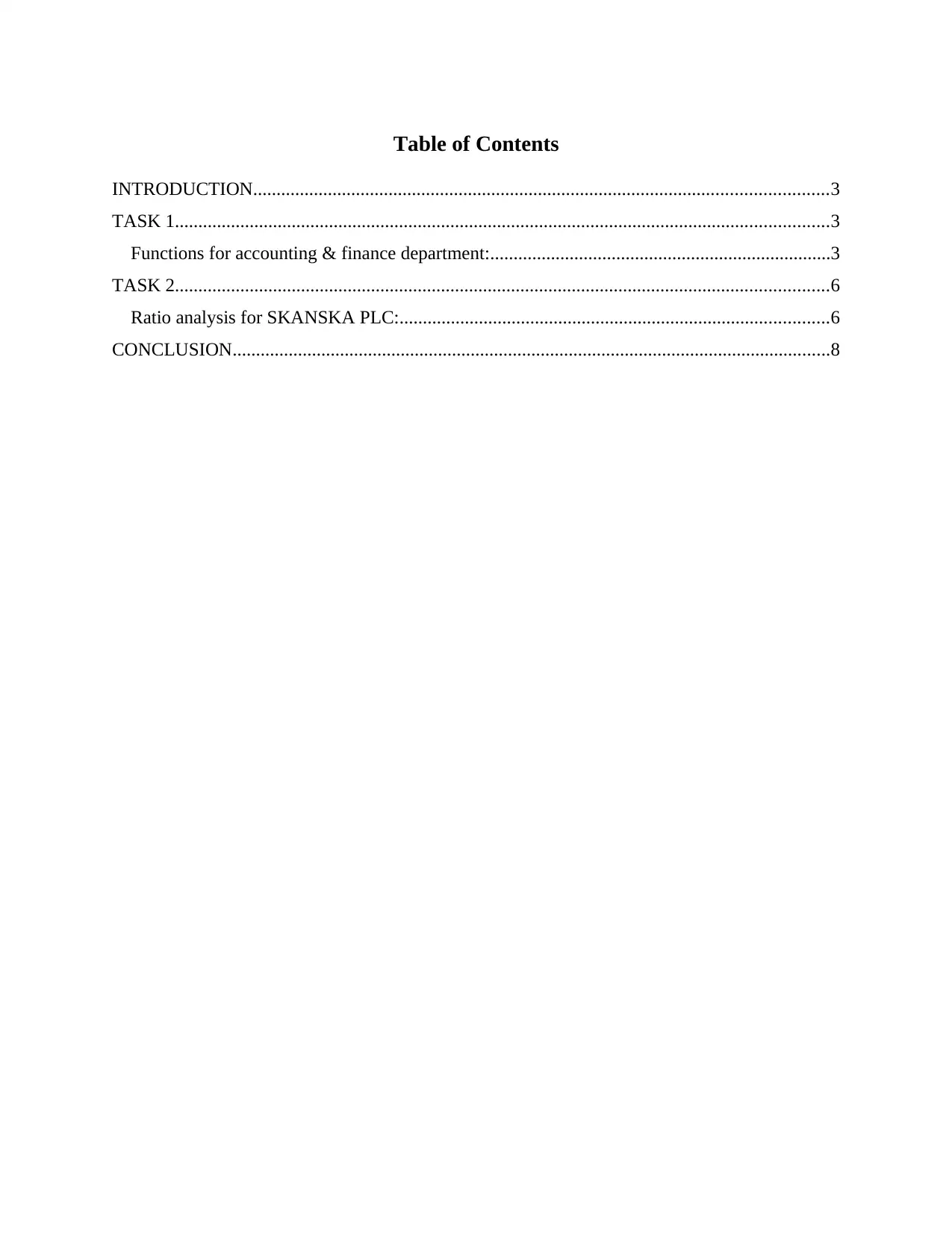
Table of Contents
INTRODUCTION...........................................................................................................................3
TASK 1............................................................................................................................................3
Functions for accounting & finance department:.........................................................................3
TASK 2............................................................................................................................................6
Ratio analysis for SKANSKA PLC:............................................................................................6
CONCLUSION................................................................................................................................8
INTRODUCTION...........................................................................................................................3
TASK 1............................................................................................................................................3
Functions for accounting & finance department:.........................................................................3
TASK 2............................................................................................................................................6
Ratio analysis for SKANSKA PLC:............................................................................................6
CONCLUSION................................................................................................................................8
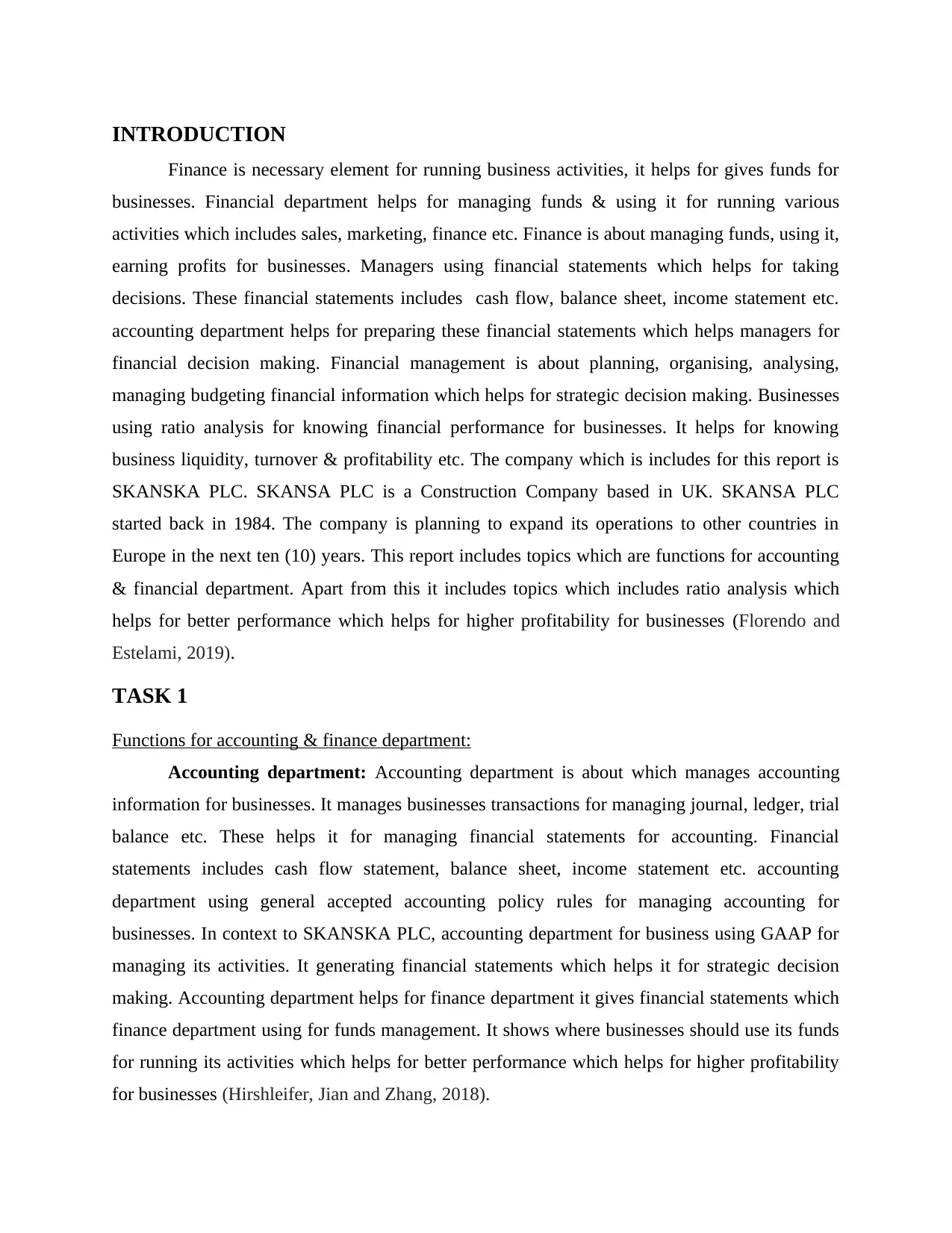
INTRODUCTION
Finance is necessary element for running business activities, it helps for gives funds for
businesses. Financial department helps for managing funds & using it for running various
activities which includes sales, marketing, finance etc. Finance is about managing funds, using it,
earning profits for businesses. Managers using financial statements which helps for taking
decisions. These financial statements includes cash flow, balance sheet, income statement etc.
accounting department helps for preparing these financial statements which helps managers for
financial decision making. Financial management is about planning, organising, analysing,
managing budgeting financial information which helps for strategic decision making. Businesses
using ratio analysis for knowing financial performance for businesses. It helps for knowing
business liquidity, turnover & profitability etc. The company which is includes for this report is
SKANSKA PLC. SKANSA PLC is a Construction Company based in UK. SKANSA PLC
started back in 1984. The company is planning to expand its operations to other countries in
Europe in the next ten (10) years. This report includes topics which are functions for accounting
& financial department. Apart from this it includes topics which includes ratio analysis which
helps for better performance which helps for higher profitability for businesses (Florendo and
Estelami, 2019).
TASK 1
Functions for accounting & finance department:
Accounting department: Accounting department is about which manages accounting
information for businesses. It manages businesses transactions for managing journal, ledger, trial
balance etc. These helps it for managing financial statements for accounting. Financial
statements includes cash flow statement, balance sheet, income statement etc. accounting
department using general accepted accounting policy rules for managing accounting for
businesses. In context to SKANSKA PLC, accounting department for business using GAAP for
managing its activities. It generating financial statements which helps it for strategic decision
making. Accounting department helps for finance department it gives financial statements which
finance department using for funds management. It shows where businesses should use its funds
for running its activities which helps for better performance which helps for higher profitability
for businesses (Hirshleifer, Jian and Zhang, 2018).
Finance is necessary element for running business activities, it helps for gives funds for
businesses. Financial department helps for managing funds & using it for running various
activities which includes sales, marketing, finance etc. Finance is about managing funds, using it,
earning profits for businesses. Managers using financial statements which helps for taking
decisions. These financial statements includes cash flow, balance sheet, income statement etc.
accounting department helps for preparing these financial statements which helps managers for
financial decision making. Financial management is about planning, organising, analysing,
managing budgeting financial information which helps for strategic decision making. Businesses
using ratio analysis for knowing financial performance for businesses. It helps for knowing
business liquidity, turnover & profitability etc. The company which is includes for this report is
SKANSKA PLC. SKANSA PLC is a Construction Company based in UK. SKANSA PLC
started back in 1984. The company is planning to expand its operations to other countries in
Europe in the next ten (10) years. This report includes topics which are functions for accounting
& financial department. Apart from this it includes topics which includes ratio analysis which
helps for better performance which helps for higher profitability for businesses (Florendo and
Estelami, 2019).
TASK 1
Functions for accounting & finance department:
Accounting department: Accounting department is about which manages accounting
information for businesses. It manages businesses transactions for managing journal, ledger, trial
balance etc. These helps it for managing financial statements for accounting. Financial
statements includes cash flow statement, balance sheet, income statement etc. accounting
department using general accepted accounting policy rules for managing accounting for
businesses. In context to SKANSKA PLC, accounting department for business using GAAP for
managing its activities. It generating financial statements which helps it for strategic decision
making. Accounting department helps for finance department it gives financial statements which
finance department using for funds management. It shows where businesses should use its funds
for running its activities which helps for better performance which helps for higher profitability
for businesses (Hirshleifer, Jian and Zhang, 2018).
⊘ This is a preview!⊘
Do you want full access?
Subscribe today to unlock all pages.

Trusted by 1+ million students worldwide
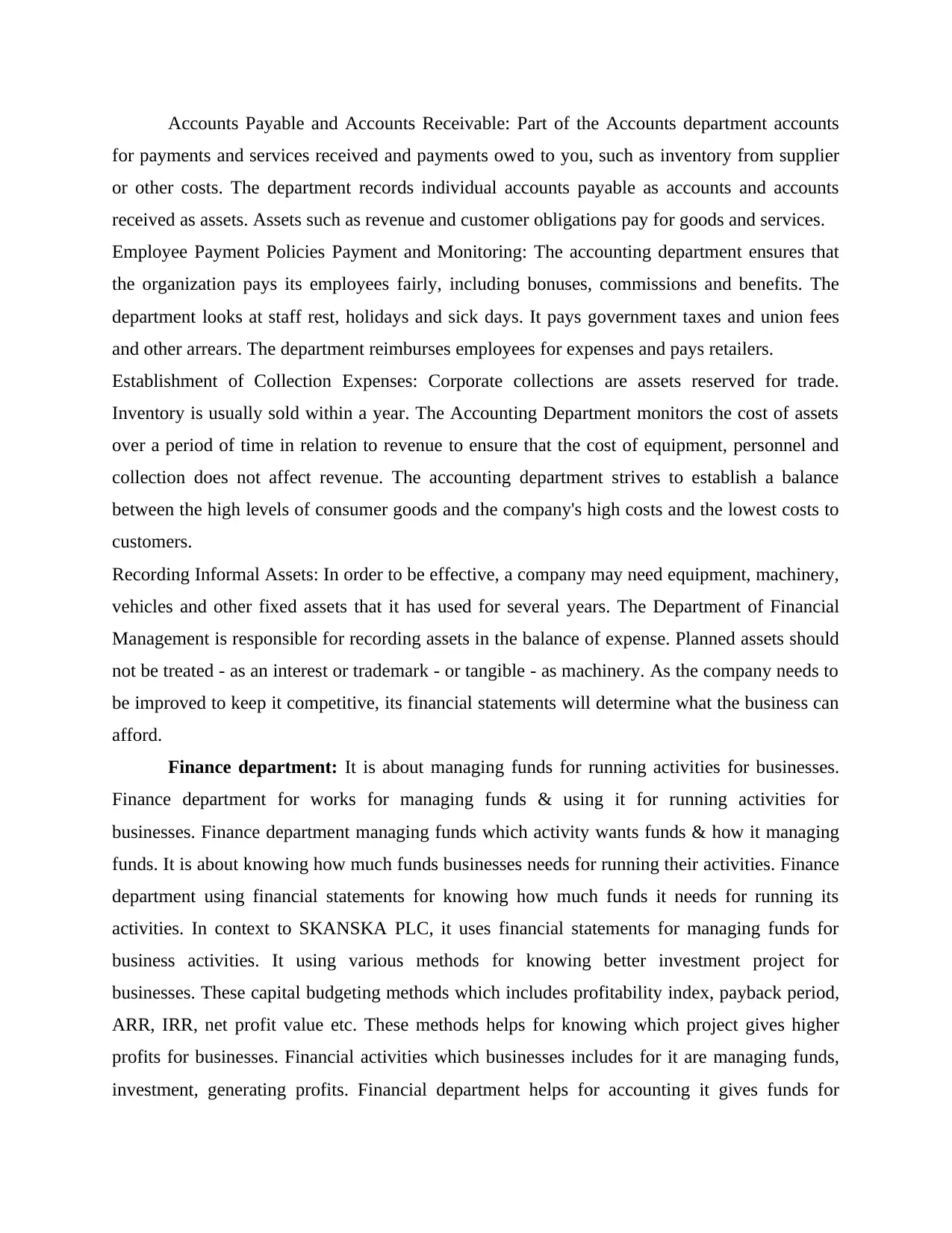
Accounts Payable and Accounts Receivable: Part of the Accounts department accounts
for payments and services received and payments owed to you, such as inventory from supplier
or other costs. The department records individual accounts payable as accounts and accounts
received as assets. Assets such as revenue and customer obligations pay for goods and services.
Employee Payment Policies Payment and Monitoring: The accounting department ensures that
the organization pays its employees fairly, including bonuses, commissions and benefits. The
department looks at staff rest, holidays and sick days. It pays government taxes and union fees
and other arrears. The department reimburses employees for expenses and pays retailers.
Establishment of Collection Expenses: Corporate collections are assets reserved for trade.
Inventory is usually sold within a year. The Accounting Department monitors the cost of assets
over a period of time in relation to revenue to ensure that the cost of equipment, personnel and
collection does not affect revenue. The accounting department strives to establish a balance
between the high levels of consumer goods and the company's high costs and the lowest costs to
customers.
Recording Informal Assets: In order to be effective, a company may need equipment, machinery,
vehicles and other fixed assets that it has used for several years. The Department of Financial
Management is responsible for recording assets in the balance of expense. Planned assets should
not be treated - as an interest or trademark - or tangible - as machinery. As the company needs to
be improved to keep it competitive, its financial statements will determine what the business can
afford.
Finance department: It is about managing funds for running activities for businesses.
Finance department for works for managing funds & using it for running activities for
businesses. Finance department managing funds which activity wants funds & how it managing
funds. It is about knowing how much funds businesses needs for running their activities. Finance
department using financial statements for knowing how much funds it needs for running its
activities. In context to SKANSKA PLC, it uses financial statements for managing funds for
business activities. It using various methods for knowing better investment project for
businesses. These capital budgeting methods which includes profitability index, payback period,
ARR, IRR, net profit value etc. These methods helps for knowing which project gives higher
profits for businesses. Financial activities which businesses includes for it are managing funds,
investment, generating profits. Financial department helps for accounting it gives funds for
for payments and services received and payments owed to you, such as inventory from supplier
or other costs. The department records individual accounts payable as accounts and accounts
received as assets. Assets such as revenue and customer obligations pay for goods and services.
Employee Payment Policies Payment and Monitoring: The accounting department ensures that
the organization pays its employees fairly, including bonuses, commissions and benefits. The
department looks at staff rest, holidays and sick days. It pays government taxes and union fees
and other arrears. The department reimburses employees for expenses and pays retailers.
Establishment of Collection Expenses: Corporate collections are assets reserved for trade.
Inventory is usually sold within a year. The Accounting Department monitors the cost of assets
over a period of time in relation to revenue to ensure that the cost of equipment, personnel and
collection does not affect revenue. The accounting department strives to establish a balance
between the high levels of consumer goods and the company's high costs and the lowest costs to
customers.
Recording Informal Assets: In order to be effective, a company may need equipment, machinery,
vehicles and other fixed assets that it has used for several years. The Department of Financial
Management is responsible for recording assets in the balance of expense. Planned assets should
not be treated - as an interest or trademark - or tangible - as machinery. As the company needs to
be improved to keep it competitive, its financial statements will determine what the business can
afford.
Finance department: It is about managing funds for running activities for businesses.
Finance department for works for managing funds & using it for running activities for
businesses. Finance department managing funds which activity wants funds & how it managing
funds. It is about knowing how much funds businesses needs for running their activities. Finance
department using financial statements for knowing how much funds it needs for running its
activities. In context to SKANSKA PLC, it uses financial statements for managing funds for
business activities. It using various methods for knowing better investment project for
businesses. These capital budgeting methods which includes profitability index, payback period,
ARR, IRR, net profit value etc. These methods helps for knowing which project gives higher
profits for businesses. Financial activities which businesses includes for it are managing funds,
investment, generating profits. Financial department helps for accounting it gives funds for
Paraphrase This Document
Need a fresh take? Get an instant paraphrase of this document with our AI Paraphraser
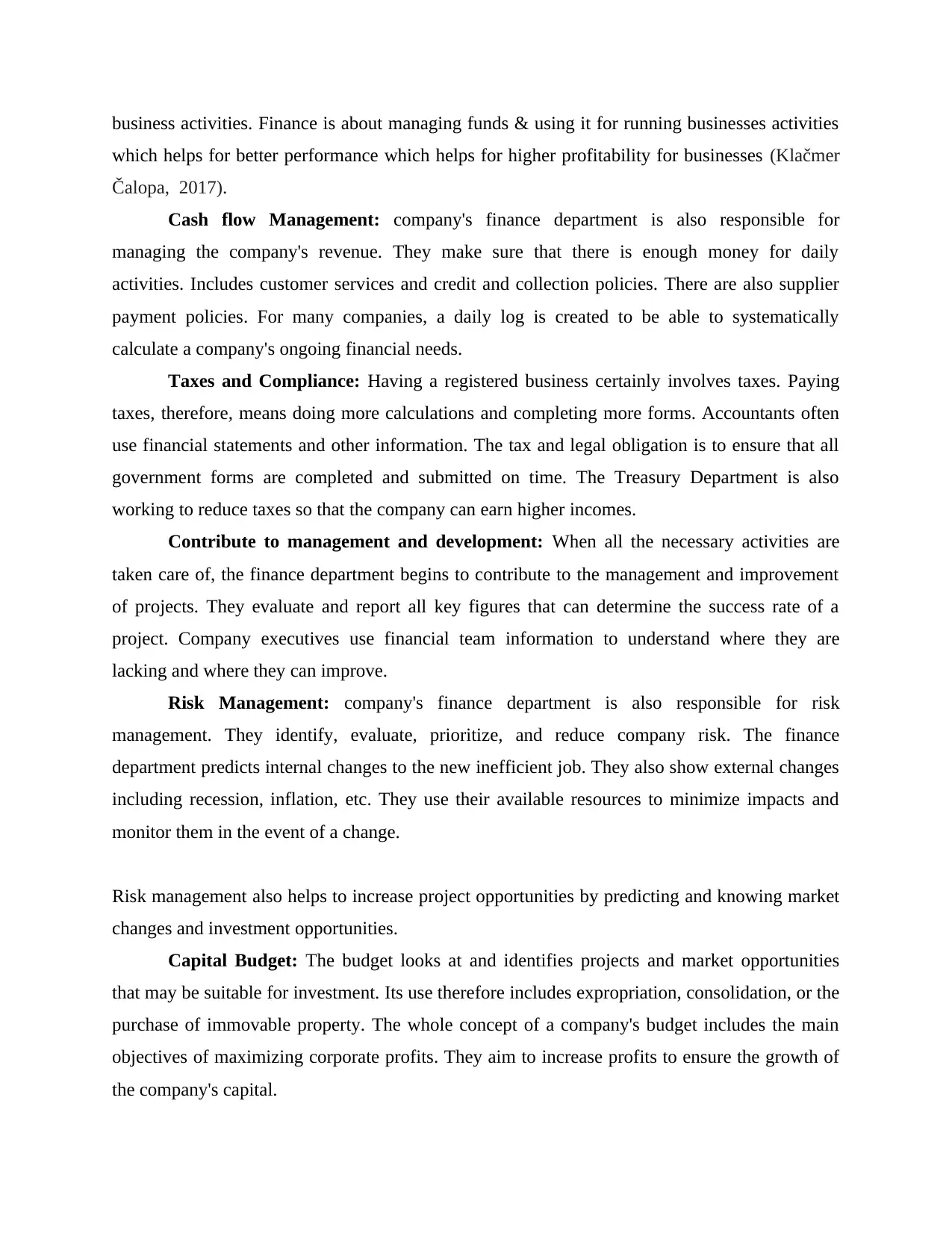
business activities. Finance is about managing funds & using it for running businesses activities
which helps for better performance which helps for higher profitability for businesses (Klačmer
Čalopa, 2017).
Cash flow Management: company's finance department is also responsible for
managing the company's revenue. They make sure that there is enough money for daily
activities. Includes customer services and credit and collection policies. There are also supplier
payment policies. For many companies, a daily log is created to be able to systematically
calculate a company's ongoing financial needs.
Taxes and Compliance: Having a registered business certainly involves taxes. Paying
taxes, therefore, means doing more calculations and completing more forms. Accountants often
use financial statements and other information. The tax and legal obligation is to ensure that all
government forms are completed and submitted on time. The Treasury Department is also
working to reduce taxes so that the company can earn higher incomes.
Contribute to management and development: When all the necessary activities are
taken care of, the finance department begins to contribute to the management and improvement
of projects. They evaluate and report all key figures that can determine the success rate of a
project. Company executives use financial team information to understand where they are
lacking and where they can improve.
Risk Management: company's finance department is also responsible for risk
management. They identify, evaluate, prioritize, and reduce company risk. The finance
department predicts internal changes to the new inefficient job. They also show external changes
including recession, inflation, etc. They use their available resources to minimize impacts and
monitor them in the event of a change.
Risk management also helps to increase project opportunities by predicting and knowing market
changes and investment opportunities.
Capital Budget: The budget looks at and identifies projects and market opportunities
that may be suitable for investment. Its use therefore includes expropriation, consolidation, or the
purchase of immovable property. The whole concept of a company's budget includes the main
objectives of maximizing corporate profits. They aim to increase profits to ensure the growth of
the company's capital.
which helps for better performance which helps for higher profitability for businesses (Klačmer
Čalopa, 2017).
Cash flow Management: company's finance department is also responsible for
managing the company's revenue. They make sure that there is enough money for daily
activities. Includes customer services and credit and collection policies. There are also supplier
payment policies. For many companies, a daily log is created to be able to systematically
calculate a company's ongoing financial needs.
Taxes and Compliance: Having a registered business certainly involves taxes. Paying
taxes, therefore, means doing more calculations and completing more forms. Accountants often
use financial statements and other information. The tax and legal obligation is to ensure that all
government forms are completed and submitted on time. The Treasury Department is also
working to reduce taxes so that the company can earn higher incomes.
Contribute to management and development: When all the necessary activities are
taken care of, the finance department begins to contribute to the management and improvement
of projects. They evaluate and report all key figures that can determine the success rate of a
project. Company executives use financial team information to understand where they are
lacking and where they can improve.
Risk Management: company's finance department is also responsible for risk
management. They identify, evaluate, prioritize, and reduce company risk. The finance
department predicts internal changes to the new inefficient job. They also show external changes
including recession, inflation, etc. They use their available resources to minimize impacts and
monitor them in the event of a change.
Risk management also helps to increase project opportunities by predicting and knowing market
changes and investment opportunities.
Capital Budget: The budget looks at and identifies projects and market opportunities
that may be suitable for investment. Its use therefore includes expropriation, consolidation, or the
purchase of immovable property. The whole concept of a company's budget includes the main
objectives of maximizing corporate profits. They aim to increase profits to ensure the growth of
the company's capital.
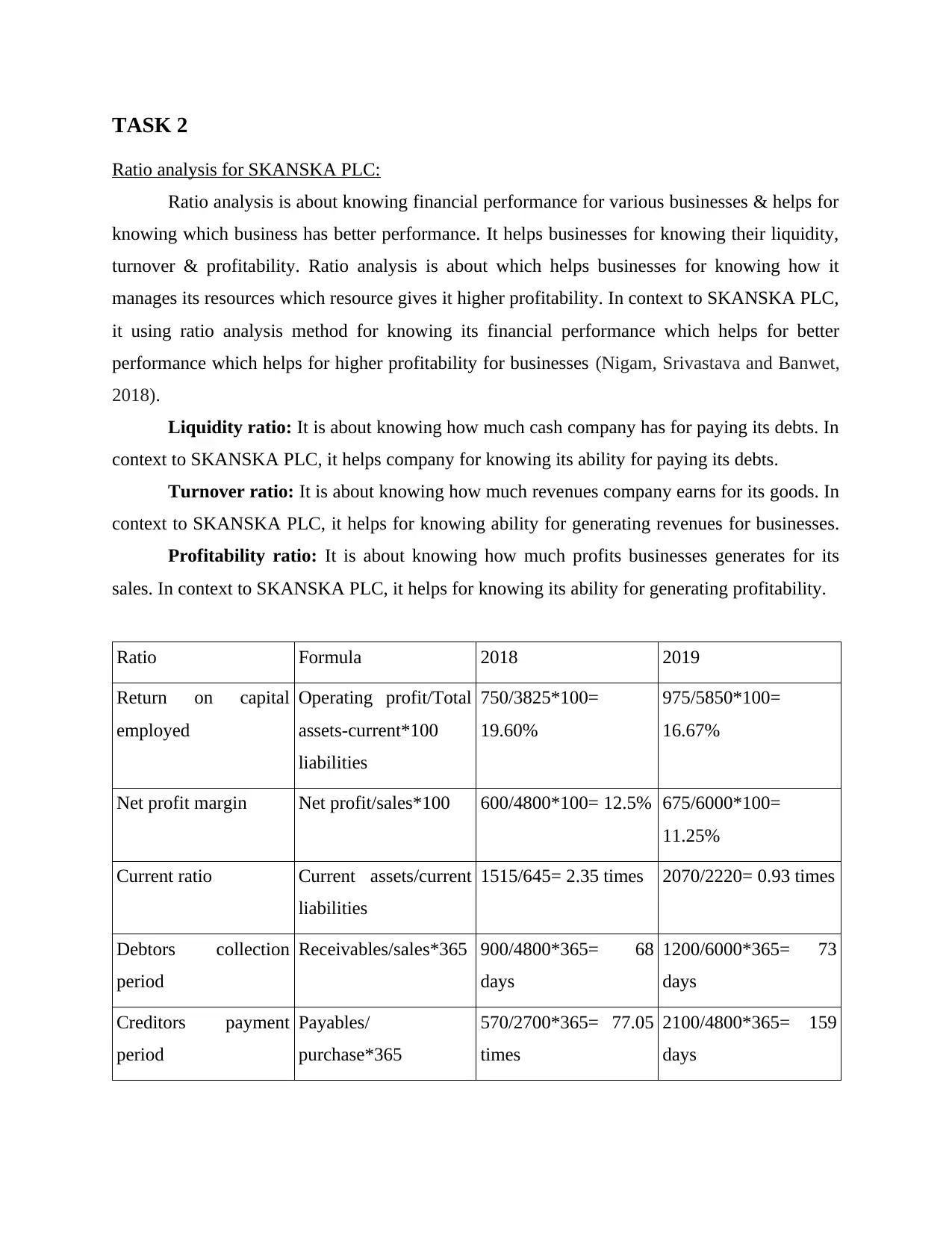
TASK 2
Ratio analysis for SKANSKA PLC:
Ratio analysis is about knowing financial performance for various businesses & helps for
knowing which business has better performance. It helps businesses for knowing their liquidity,
turnover & profitability. Ratio analysis is about which helps businesses for knowing how it
manages its resources which resource gives it higher profitability. In context to SKANSKA PLC,
it using ratio analysis method for knowing its financial performance which helps for better
performance which helps for higher profitability for businesses (Nigam, Srivastava and Banwet,
2018).
Liquidity ratio: It is about knowing how much cash company has for paying its debts. In
context to SKANSKA PLC, it helps company for knowing its ability for paying its debts.
Turnover ratio: It is about knowing how much revenues company earns for its goods. In
context to SKANSKA PLC, it helps for knowing ability for generating revenues for businesses.
Profitability ratio: It is about knowing how much profits businesses generates for its
sales. In context to SKANSKA PLC, it helps for knowing its ability for generating profitability.
Ratio Formula 2018 2019
Return on capital
employed
Operating profit/Total
assets-current*100
liabilities
750/3825*100=
19.60%
975/5850*100=
16.67%
Net profit margin Net profit/sales*100 600/4800*100= 12.5% 675/6000*100=
11.25%
Current ratio Current assets/current
liabilities
1515/645= 2.35 times 2070/2220= 0.93 times
Debtors collection
period
Receivables/sales*365 900/4800*365= 68
days
1200/6000*365= 73
days
Creditors payment
period
Payables/
purchase*365
570/2700*365= 77.05
times
2100/4800*365= 159
days
Ratio analysis for SKANSKA PLC:
Ratio analysis is about knowing financial performance for various businesses & helps for
knowing which business has better performance. It helps businesses for knowing their liquidity,
turnover & profitability. Ratio analysis is about which helps businesses for knowing how it
manages its resources which resource gives it higher profitability. In context to SKANSKA PLC,
it using ratio analysis method for knowing its financial performance which helps for better
performance which helps for higher profitability for businesses (Nigam, Srivastava and Banwet,
2018).
Liquidity ratio: It is about knowing how much cash company has for paying its debts. In
context to SKANSKA PLC, it helps company for knowing its ability for paying its debts.
Turnover ratio: It is about knowing how much revenues company earns for its goods. In
context to SKANSKA PLC, it helps for knowing ability for generating revenues for businesses.
Profitability ratio: It is about knowing how much profits businesses generates for its
sales. In context to SKANSKA PLC, it helps for knowing its ability for generating profitability.
Ratio Formula 2018 2019
Return on capital
employed
Operating profit/Total
assets-current*100
liabilities
750/3825*100=
19.60%
975/5850*100=
16.67%
Net profit margin Net profit/sales*100 600/4800*100= 12.5% 675/6000*100=
11.25%
Current ratio Current assets/current
liabilities
1515/645= 2.35 times 2070/2220= 0.93 times
Debtors collection
period
Receivables/sales*365 900/4800*365= 68
days
1200/6000*365= 73
days
Creditors payment
period
Payables/
purchase*365
570/2700*365= 77.05
times
2100/4800*365= 159
days
⊘ This is a preview!⊘
Do you want full access?
Subscribe today to unlock all pages.

Trusted by 1+ million students worldwide

Return on capital employed ratio: It is about which shows relation for capital & its
earning. Higher the ratio shows higher earning for businesses which shows its ability for using its
capital. It is about businesses using its capital for generating income which shows earning which
is generate for business capital. In context to SKANAKA PLC, it shows information for 2018 &
2019. as per this ratio it shows for 2018 it has 19.60% & for 2019 it has 16.67%. It shows
business should manage its capital for better performance it should manage its resources. For
2019 business was not able for use its capital which was reason for decrease its ratio. Company
should use its resources for better manner which helps it for generate higher sales. Sales is key
for every business which helps for maintaining its resources which helps for better performance
which helps for higher profitability for businesses (Rai and Lin, 2019).
Net profit ratio: It is about which shows relation for net profit & sales for businesses.
Higher net profit ratio shows higher profits for business for its sales. It is about which shows
business ability for generating profits for its sales. It is calculated by profits divide sales for
businesses. Net profit calculates after showing expenses which shows sales minus expenses is
known as profit. In context to SKANSKA PLC, it shows ratios for 2018 & 2019. as per above
information it shows for 2018 its 12.5% & for 2019 its 11.25%. net profit ratio shows company's
ability for generating income for its sales. This ratio shows company has generated less profits
for 2019. it should manage its sales which helps for generating profits. It should managing its
pricing strategy, sales, brand value which helps it for attracting customers which helps for better
performance which helps for higher profitability for businesses (Rasheed and Siddiqui, 2019).
Current ratio: It is about which shows relation for current liabilities & current assets. It
shows how much ability business has for paying its debts. It is known as working capital ratio. It
shows how much cash business has for paying its debts. Business has cash for paying its debts
which attracts investors for investing funds for businesses. In context to SKANSKA PLC,
business should manage its cash for paying its debts. It using this ratio for knowing its business
ability for paying its debts. It shows ratios for 2018 & 2019. as per above information it shows
ratios for 2018 its 2.35 & for 2019 its 0.93. It shows business has better performance for 2018.
for 2019 it decreases its ratio which shows business should manage its cash for running its
activities which helps it for paying debts. Management department needs for viewing its assets
managing rules & managing its costs activities which helps for managing current ratio which
earning. Higher the ratio shows higher earning for businesses which shows its ability for using its
capital. It is about businesses using its capital for generating income which shows earning which
is generate for business capital. In context to SKANAKA PLC, it shows information for 2018 &
2019. as per this ratio it shows for 2018 it has 19.60% & for 2019 it has 16.67%. It shows
business should manage its capital for better performance it should manage its resources. For
2019 business was not able for use its capital which was reason for decrease its ratio. Company
should use its resources for better manner which helps it for generate higher sales. Sales is key
for every business which helps for maintaining its resources which helps for better performance
which helps for higher profitability for businesses (Rai and Lin, 2019).
Net profit ratio: It is about which shows relation for net profit & sales for businesses.
Higher net profit ratio shows higher profits for business for its sales. It is about which shows
business ability for generating profits for its sales. It is calculated by profits divide sales for
businesses. Net profit calculates after showing expenses which shows sales minus expenses is
known as profit. In context to SKANSKA PLC, it shows ratios for 2018 & 2019. as per above
information it shows for 2018 its 12.5% & for 2019 its 11.25%. net profit ratio shows company's
ability for generating income for its sales. This ratio shows company has generated less profits
for 2019. it should manage its sales which helps for generating profits. It should managing its
pricing strategy, sales, brand value which helps it for attracting customers which helps for better
performance which helps for higher profitability for businesses (Rasheed and Siddiqui, 2019).
Current ratio: It is about which shows relation for current liabilities & current assets. It
shows how much ability business has for paying its debts. It is known as working capital ratio. It
shows how much cash business has for paying its debts. Business has cash for paying its debts
which attracts investors for investing funds for businesses. In context to SKANSKA PLC,
business should manage its cash for paying its debts. It using this ratio for knowing its business
ability for paying its debts. It shows ratios for 2018 & 2019. as per above information it shows
ratios for 2018 its 2.35 & for 2019 its 0.93. It shows business has better performance for 2018.
for 2019 it decreases its ratio which shows business should manage its cash for running its
activities which helps it for paying debts. Management department needs for viewing its assets
managing rules & managing its costs activities which helps for managing current ratio which
Paraphrase This Document
Need a fresh take? Get an instant paraphrase of this document with our AI Paraphraser

helps for better performance which helps for higher profitability for businesses (Sobkow,
Garrido and Garcia-Retamero, 2020).
Debtors collection period: It is about which shows businesses ability for collecting its
debts by customers for their purchases. Lower collection ratio shows company has better
performance which helps it for managing its liquidity. It is about how much period it takes for
collecting its cash by customers. It shows relation for average receivables & sales. It is known as
debtors turnover ratio. The earlier business takes its cash by customers it helps it for increasing
its sales which gives higher profits. In context to SKANSKA PLC, it using this ratio for knowing
businesses ability for collecting cash by its customers. It shows ratios for 2018 & 2019. as per
above ratio it shows for 2018 it 68 & for 2019 it 73. it shows business has more days for
collecting its payment for 2019 which shows it should manage its debtors collection rules.
Earlier it gets cash by customers will helps it for managing its sales which gives higher
profitability. It should manage its cash collection which helps for better performance which helps
for higher profitability for businesses.
Creditors collection period: It is about knowing how much ability businesses has for
paying its debts. It shows relation for average creditors & purchases. The higher collection
period beneficial for businesses. It is known as creditors turnover ratio. It is about when business
pays its dues which shows its ability for paying its debts. In context to SKANSKA PLC, it shows
business ability for paying its debts. It shows ratios for 2018 & 2019. as per above ratios it shows
for 2018 it 77.05 & 2019 it 159. it shows for 2019 business paying its debts late which shows it
manages its cash for paying its debts. It shows business less ability fro paying its debts it should
manage its sales. Sales will helps it generating profits which helps for better performance which
helps for higher profitability for businesses (Yue, Gizem Korkmaz and Zhou, 2020).
CONCLUSION
From the above report it has been concluded that finance is necessary element for
businesses which helps for running their activities. Finance is about managing funds 7 using
them for generating higher profits. Finance is about which helps business for managing its
activities which includes production, marketing, finance etc. Financial management is about
planning, organising, analysing, managing budgeting financial information which helps for
strategic decision making. Businesses using ratio analysis for knowing financial performance for
businesses. Accounting department helps for managing accounting information for business for
Garrido and Garcia-Retamero, 2020).
Debtors collection period: It is about which shows businesses ability for collecting its
debts by customers for their purchases. Lower collection ratio shows company has better
performance which helps it for managing its liquidity. It is about how much period it takes for
collecting its cash by customers. It shows relation for average receivables & sales. It is known as
debtors turnover ratio. The earlier business takes its cash by customers it helps it for increasing
its sales which gives higher profits. In context to SKANSKA PLC, it using this ratio for knowing
businesses ability for collecting cash by its customers. It shows ratios for 2018 & 2019. as per
above ratio it shows for 2018 it 68 & for 2019 it 73. it shows business has more days for
collecting its payment for 2019 which shows it should manage its debtors collection rules.
Earlier it gets cash by customers will helps it for managing its sales which gives higher
profitability. It should manage its cash collection which helps for better performance which helps
for higher profitability for businesses.
Creditors collection period: It is about knowing how much ability businesses has for
paying its debts. It shows relation for average creditors & purchases. The higher collection
period beneficial for businesses. It is known as creditors turnover ratio. It is about when business
pays its dues which shows its ability for paying its debts. In context to SKANSKA PLC, it shows
business ability for paying its debts. It shows ratios for 2018 & 2019. as per above ratios it shows
for 2018 it 77.05 & 2019 it 159. it shows for 2019 business paying its debts late which shows it
manages its cash for paying its debts. It shows business less ability fro paying its debts it should
manage its sales. Sales will helps it generating profits which helps for better performance which
helps for higher profitability for businesses (Yue, Gizem Korkmaz and Zhou, 2020).
CONCLUSION
From the above report it has been concluded that finance is necessary element for
businesses which helps for running their activities. Finance is about managing funds 7 using
them for generating higher profits. Finance is about which helps business for managing its
activities which includes production, marketing, finance etc. Financial management is about
planning, organising, analysing, managing budgeting financial information which helps for
strategic decision making. Businesses using ratio analysis for knowing financial performance for
businesses. Accounting department helps for managing accounting information for business for

generating financial statements which includes cash flow, balance sheet, income statement etc.
finance department helps for managing funds for business which helps for generating higher
profits. Businesses using ratio analysis for knowing its financial performance. It helps businesses
for knowing its liquidity, turnover, profitability. Finance is element which includes managing
funds which helps for better performance which helps for higher profitability for businesses.
finance department helps for managing funds for business which helps for generating higher
profits. Businesses using ratio analysis for knowing its financial performance. It helps businesses
for knowing its liquidity, turnover, profitability. Finance is element which includes managing
funds which helps for better performance which helps for higher profitability for businesses.
⊘ This is a preview!⊘
Do you want full access?
Subscribe today to unlock all pages.

Trusted by 1+ million students worldwide

REFERENCES
Books & journals:
Florendo, J. and Estelami, H., 2019. The role of cognitive style, gullibility, and demographics on
the use of social media for financial decision making. Journal of Financial Services
Marketing. 24(1). pp.1-10.
Hirshleifer, D., Jian, M. and Zhang, H., 2018. Superstition and financial decision making.
Management Science. 64(1). pp.235-252.
Klačmer Čalopa, M., 2017. Business owner and manager’s attitudes towards financial decision-
making and strategic planning: Evidence from Croatian SMEs. Management: journal of
contemporary management issues. 22(1). pp.103-116.
Nigam, R. M., Srivastava, S. and Banwet, D. K., 2018. Behavioral mediators of financial
decision making–a state-of-art literature review. Review of Behavioral Finance.
Rai, D. and Lin, C. W. W., 2019. The influence of implicit self-theories on consumer financial
decision making. Journal of Business Research. 95. pp.316-325.
Rasheed, R. and Siddiqui, S. H., 2019. Attitude for inclusive finance: influence of owner-
managers’ and firms’ characteristics on SMEs financial decision making. Journal of
Economic and Administrative Sciences.
Sobkow, A., Garrido, D. and Garcia-Retamero, R., 2020. Cognitive abilities and financial
decision making. In Psychological perspectives on financial decision making (pp. 71-
87). Springer, Cham.
Yue, P., Gizem Korkmaz, A. and Zhou, H., 2020. Household financial decision making amidst
the COVID-19 pandemic. Emerging Markets Finance and Trade. 56(10). pp.2363-
2377.
Books & journals:
Florendo, J. and Estelami, H., 2019. The role of cognitive style, gullibility, and demographics on
the use of social media for financial decision making. Journal of Financial Services
Marketing. 24(1). pp.1-10.
Hirshleifer, D., Jian, M. and Zhang, H., 2018. Superstition and financial decision making.
Management Science. 64(1). pp.235-252.
Klačmer Čalopa, M., 2017. Business owner and manager’s attitudes towards financial decision-
making and strategic planning: Evidence from Croatian SMEs. Management: journal of
contemporary management issues. 22(1). pp.103-116.
Nigam, R. M., Srivastava, S. and Banwet, D. K., 2018. Behavioral mediators of financial
decision making–a state-of-art literature review. Review of Behavioral Finance.
Rai, D. and Lin, C. W. W., 2019. The influence of implicit self-theories on consumer financial
decision making. Journal of Business Research. 95. pp.316-325.
Rasheed, R. and Siddiqui, S. H., 2019. Attitude for inclusive finance: influence of owner-
managers’ and firms’ characteristics on SMEs financial decision making. Journal of
Economic and Administrative Sciences.
Sobkow, A., Garrido, D. and Garcia-Retamero, R., 2020. Cognitive abilities and financial
decision making. In Psychological perspectives on financial decision making (pp. 71-
87). Springer, Cham.
Yue, P., Gizem Korkmaz, A. and Zhou, H., 2020. Household financial decision making amidst
the COVID-19 pandemic. Emerging Markets Finance and Trade. 56(10). pp.2363-
2377.
1 out of 10
Related Documents
Your All-in-One AI-Powered Toolkit for Academic Success.
+13062052269
info@desklib.com
Available 24*7 on WhatsApp / Email
![[object Object]](/_next/static/media/star-bottom.7253800d.svg)
Unlock your academic potential
Copyright © 2020–2025 A2Z Services. All Rights Reserved. Developed and managed by ZUCOL.




